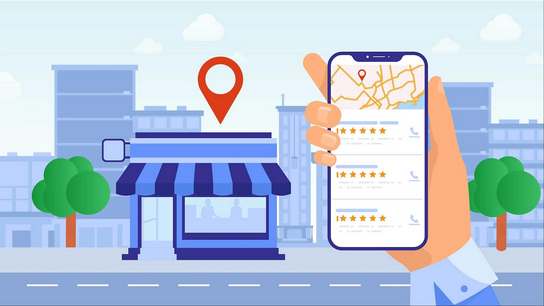
Comprehensive SEO Tutorial – Learn SEO Like a Pro, Step by Step

Comprehensive SEO Tutorial – Learn SEO Like a Pro, Step by Step
Most SEO tutorials overcomplicate things.
They throw jargon at you, show 100 tools you’ll never use, and leave you more confused than when you started.
The truth: SEO isn’t rocket science.
In fact, when you follow a step-by-step system, you can go from zero to ranking on Google faster than you think.
✅ Want more organic traffic?
✅ Want to appear on Page 1 instead of Page 10?
✅ Want SEO strategies that actually work in 2025?
That’s exactly what you’ll learn here.
This isn't a theory. I’ll walk you through proven strategies, show you real examples, and share case studies from websites that grew their traffic using these exact steps.
You’re about to learn exactly how to master SEO — step by step.
Understand How Search Engines Work
Before you even think about optimizing your site, you need to understand what SEO is really aiming at.
Most people think Google is just a giant phonebook of websites. But that’s not true.
Google is much smarter than that. It’s not a directory — it’s an answer machine.
Whenever someone types a question like “best running shoes for beginners,” Google’s mission is simple:
👉 Deliver the most relevant, accurate, and high-quality answer possible.
But how does it figure that out?
That’s where the magic (and science) of search comes in.
Step 1: Crawling – Finding Your Website
Imagine Google has an army of little robots (called crawlers or spiders) constantly roaming the internet.
Their job is to:
- Discover new pages.
- Revisit old pages to see if anything has changed.
- Follow links from one site to another.
Think of it like Google’s scouts mapping out the web.
If you publish a new blog post today and link it from your homepage, Google’s crawlers can follow that link and discover your new content.
Indexing – Storing the Information
Once a page is crawled, Google doesn’t just leave it there.
It needs to store and organize the content so it can find it later. This process is called indexing.
During indexing, Google looks at:
- The words on your page.
- Your headings, images, and videos.
- The overall structure and topic.
Then, it stores all of that information in its giant database — also known as the Google Index.
Think of this like a library. Crawling is the librarian finding new books, and indexing is when those books are added to the shelves in the right section.
Ranking – Deciding Who Gets the Spotlight
Now comes the competitive part.
When someone searches “best running shoes,” Google doesn’t just throw a random list of indexed pages at them. It carefully chooses which pages deserve to be on Page 1.
This is ranking.
Google uses complex algorithms (over 200+ factors!) to decide:
- Which page is most relevant to the search.
- Which page is the most trustworthy.
- Which page delivers the best user experience.
Example: If your content is well-written, optimized for keywords, loads fast, and has links from trusted sites, Google is more likely to rank you high.
Credit: https://media.licdn.com/
Google uses 200+ ranking factors. But don’t panic — you don’t need to know all of them. You just need to focus on the big ones:
- Relevance: Does your content match the search query?
- Authority: Does your website have trust (backlinks, mentions)?
- User Experience: Do people stay, click, and engage?
Think of Google as your strict but fair teacher. If your content answers the question better than anyone else’s, you’ll pass the test.
Do Smart Keyword Research
Here’s the deal: if you skip keyword research, you’re basically playing darts blindfolded.
You might hit something… but chances are, you’ll miss.
Keyword research is what makes SEO strategic instead of random guessing. It tells you exactly what people are searching for and whether those searches are worth your time.
The Common Problem
Most beginners make one of two mistakes when it comes to keywords:
- They aim way too high.
For example, they go after a monster keyword like “SEO” or “marketing.”
Sounds great, right? But here’s the problem — those keywords are insanely competitive. You’ll be up against industry giants like HubSpot, Moz, and Neil Patel. Good luck outranking them if you’re just starting out. - They aim way too low.
On the flip side, some people target keywords nobody’s searching for. Sure, you might rank #1… but if only 5 people a month type in that keyword, what’s the point?
This is where most new SEO strategies crash and burn.
The Smarter Approach
Instead of chasing unicorns (impossible keywords) or ghosts (no-search keywords), the key is to find the sweet spot.
That sweet spot is made up of three things:
- High search demand.
Are real people actually searching for this keyword every month? If yes, that’s a good sign. - Low to medium competition.
Can you realistically compete with the websites already ranking? If all Page 1 results are huge brands, it might not be worth it. - Business value.
This is the most overlooked one. A keyword might have traffic, but does it bring in the right kind of traffic? - Example: If you run a shoe store, ranking for “how to tie shoelaces” might get clicks… but it won’t necessarily sell shoes.
Let’s Put It Into Perspective
Imagine you own a local bakery.
- Going after the keyword “cakes” is like trying to compete with Amazon and Food Network. Too broad.
- Going after “custom blueberry lemon cake with sprinkles in Springfield” might be too niche — no one searches that.
- But targeting something like “best custom cakes in Springfield”? That’s the sweet spot. Enough people are searching for it, and you can realistically rank since you’re targeting your local area.
Tools You Can Use:
- Google Keyword Planner (free).
- Ahrefs Keywords Explorer.
Case Study:Backlinko grew its organic traffic by 110% in 14 days by updating content with new keyword opportunities by using their skyscraper technique. |
Create Content That Actually Ranks
Content is the real engine that powers SEO. You can spend months building backlinks or fine-tuning your technical setup, but if your content is weak, none of those efforts will take you far. Google’s ultimate priority is delivering value to searchers, and that value almost always comes down to the quality of the content you put out.
So, what actually works in 2025 when it comes to content? It’s not about stuffing keywords or writing endless walls of text. Instead, focus on three simple but powerful things:
- Comprehensive coverage of the topic so the reader doesn’t feel the need to go anywhere else.
- Conversational tone that feels easy to read, like you’re talking to a friend and not lecturing.
- Clear formatting with subheadings, bullet points, and short paragraphs so readers can scan quickly.
On top of that, visuals are your secret weapon. Screenshots, charts, infographics, and even quick explainer videos break up text and make your content stickier. Readers stay longer, and that’s exactly the kind of engagement signal Google pays attention to.
Credits: https://static.semrush.com/
A powerful way to create content that ranks is by using the Skyscraper Technique. The process is straightforward but highly effective:
- Find the best-performing content on your chosen topic.
- Study it carefully and identify where it falls short.
- Create something 10x better by adding more depth, updated stats, and fresh visuals.
- Promote it to the right audience so people discover and link back to it.
For example, if most sites have a short 500-word post on “SEO Basics,” you could step up by publishing a 2,500-word guide that includes case studies, visuals, and expert insights.
Always remember, user intent matters more than word count. If someone searches for “SEO checklist,” don’t drag it out into 5,000 words. Instead, give them a clear, scannable checklist they can actually use. That’s how you win both readers and rankings.
Optimize On-Page SEO
Once you’ve created solid content, the next step is to make sure Google actually understands it and wants to rank it. This is where On-Page SEO comes in. Think of it as fine-tuning your content so it not only appeals to readers but also sends the right signals to search engines. Done right, on-page optimization can be the difference between landing on page 10 or climbing all the way to page 1.
Here are the key on-page elements you need to master:
- Title Tag → Your title is the first thing people see on search results, so make it count. Always include your main keyword naturally, but don’t force it. Example: “Comprehensive SEO Tutorial – Learn SEO Like a Pro.” A great title is both keyword-friendly and click-worthy.
- Meta Description → This is your chance to “sell the click.” Think of it as a mini advertisement for your page. It should be compelling, clear, and reflect what users will find. Example: “Learn SEO step by step with this complete tutorial. No jargon, no fluff — just proven strategies.” Even though meta descriptions aren’t a direct ranking factor, a high click-through rate definitely helps.
- Headings (H1, H2, H3) → Structure your content like a well-organized book. Your H1 should be your main title, H2s for major sections, and H3s for subsections. This makes your content easy to scan and signals hierarchy to Google.
- Internal Links → Don’t leave your readers hanging on one page. Link to other relevant articles on your site. This spreads authority and keeps visitors engaged. Example: If you’re writing about keyword research, link to your detailed guide on long-tail keywords.
- External Links → Linking out to trusted sources shows Google (and your readers) that your content is well-researched. For instance, citing a stat from HubSpot or Ahrefs gives your content more credibility.
- Images & Alt Text → Don’t just upload images as “IMG_123.” Use descriptive filenames and add alt text that includes your keywords. Not only does this help with SEO, but it also improves accessibility and can get your content discovered via Google Images.
Credits: dearjohn.nz
Pay attention to Google’s “People Also Ask” section. These are questions your audience is literally typing into Google.
If you naturally include those Q&As in your content, you massively increase your chances of showing up in featured snippets — those highly visible answer boxes that appear at the top of search results.
Build High-Quality Backlinks
If content is the engine of SEO, backlinks are the fuel that makes it run faster.
Here’s the reality: Google still treats backlinks as one of the top ranking signals. They’re essentially votes of confidence. When another website links to you, it’s like saying: “This content is trustworthy and valuable.”
But — and this is a big but — not all backlinks are created equal.
A single backlink from Forbes or HubSpot can outweigh hundreds of random blog comments or spammy directory links. In fact, low-quality backlinks can even hurt you if they look manipulative. That’s why the focus has to be on quality over quantity.
So, how do you actually earn backlinks that move the needle? Let’s look at some proven strategies:
- Guest Posting → Write valuable content for other websites in your industry. Not only does this build backlinks, but it also introduces you to a new audience.
Example: Contributing a guest post on a marketing blog about “AI in SEO” and linking back to your own case study. - Resource Pages → Many sites publish lists like “Best SEO Tools” or “Top Marketing Resources.” Pitch your content to be included. If your guide is solid, editors often welcome high-quality additions.
- Broken Link Building → This is one of the most underrated tactics. Find broken (dead) links on relevant websites, create content that replaces the missing resource, and politely reach out suggesting your link as the fix. Website owners appreciate it because you’re helping them improve their user experience.
- Skyscraper Outreach → Take an existing piece of content that has backlinks, make something 10x better, and then show it to the sites that linked to the weaker version. If your resource genuinely adds more value, many will update their links to point to yours.
Credits: analytify.io
|
Case Study: Ahrefs, one of the biggest SEO tools today, didn’t grow by pumping money into ads. Instead, they built their authority by publishing data-driven case studies and in-depth research posts. Those unique insights earned them thousands of backlinks from journalists, bloggers, and industry leaders. Today, Ahrefs is seen as one of the most trusted sources in the SEO space. |
Don’t chase backlinks like they’re lottery tickets. Instead, focus on creating content worth linking to — whether it’s original research, helpful tools, or detailed tutorials. Outreach becomes 10x easier when your content is genuinely valuable.
Step #6: Improve Technical SEO
Let’s be real — even the most amazing content won’t shine if your website has technical issues.
Think of technical SEO like a health check-up for your site. If your site is slow, messy, or broken, Google won’t take it seriously… and neither will your visitors.
The good news? Most technical fixes are straightforward once you know what to look for.
Here’s a technical SEO checklist you can follow:
✅ Fast site speed → Aim for a load time under 2 seconds. Nobody likes waiting, and Google definitely notices when your site lags. Use tools like Google PageSpeed Insights or GTmetrix to see what’s slowing things down. Often, it’s heavy images, too many plugins, or poor hosting.
✅ Mobile-friendly design → More than half of web traffic today comes from mobile devices. If your site isn’t responsive, users will bounce (and rankings will drop). Test your site on different screen sizes to make sure everything looks clean and easy to navigate.
✅ Secure connection (HTTPS) → Google flat-out says that security is a ranking factor. If you’re still on HTTP, switch to HTTPS with an SSL certificate. Not only does it help with SEO, but it also builds trust with your audience.
✅ Fix broken links and errors → Imagine clicking a link only to land on a 404 error page. Frustrating, right? Too many broken links can harm user experience and your SEO performance. Tools like Screaming Frog or even free broken link checkers can help you catch and fix them quickly.
✅ XML Sitemap → This is like a roadmap you give to Google. An updated sitemap makes it easier for search engines to crawl and index your content properly. You can generate one easily with plugins like Yoast SEO (WordPress) or online sitemap tools.
Credits: www.sistrix.co
Don’t forget about Google Search Console. It’s free, and it’s like having direct feedback from Google itself. You’ll see indexing issues, crawl errors, mobile usability problems, and even the keywords your site is ranking for. Regularly checking Search Console can help you catch small problems before they turn into big ones.
Bottom line? Technical SEO isn’t flashy, but it’s the backbone of your site’s performance. Nail this, and you’ll give your content the best chance to rank.
Measure, Test & Optimize
SEO isn’t something you do once and then walk away from. It’s more like a fitness routine — you need to keep tracking your progress, tweaking your approach, and improving over time. Otherwise, you’ll have no idea whether your efforts are actually paying off.
Let’s break this down into three simple parts:
1. The Tools You Need
First things first — you can’t optimize what you don’t measure. Luckily, there are some powerful (and often free) tools that make tracking your SEO progress easy:
- Google Analytics → Your go-to dashboard for traffic and user behavior. You’ll see where your visitors are coming from, how long they stay, and which pages keep them hooked.
- Google Search Console → Direct feedback from Google itself. It shows your rankings, impressions, clicks, and even which queries people use to find you.
- Ahrefs / SEMrush → Premium tools, but worth it if you want deeper insights into backlinks, keyword tracking, and competitor analysis.
Think of these tools as your fitness tracker for SEO — they’ll show you what’s working and what needs a tune-up.
2. What to Actually Measure
Now that you have the tools, what should you look at? Too many people get lost in endless data, so let’s focus on what actually matters:
- Organic traffic growth → Is your site getting more visitors from search over time? That’s the ultimate sign your SEO strategy is working.
- Keyword rankings → Are you climbing the SERPs for your target terms? Track your movement weekly or monthly.
- CTR (Click-Through Rate) → If people see your page but don’t click, you may need to improve your titles and meta descriptions.
- Bounce rate & dwell time → If visitors leave quickly, maybe your content isn’t engaging enough — or it didn’t match their intent.
These metrics are like your SEO health report. They help you understand not just how much traffic you’re getting, but the quality of that traffic.
3. The Reality Check
Here’s the part most beginners miss: SEO takes time.
Don’t expect overnight results. In fact, depending on your niche and competition, it may take 3–6 months before you see big changes.
That’s why regular testing and tweaking are so important. Maybe your blog post needs better headlines, or your product page needs a faster loading speed. Small changes, when tracked over time, can have a massive impact on rankings and conversions.
Keep a simple SEO log — every time you make a change (like updating content, adding backlinks, or fixing technical issues), write it down. Then, when you check your metrics, you’ll know exactly what caused the shift.
SEO isn’t a sprint, it’s a marathon. The people who win are the ones who measure, test, and keep optimizing.
Credits: https://api.backlinko.com/
Important:
SEO results take time. Expect 3–6 months before seeing big changes.
Resources & Tools
Here are my top picks for SEO tools (free + paid):
- Google Search Console (Free) – Essential for tracking performance.
- Ahrefs (Paid) – Keyword research + backlinks.
- SEMrush (Paid) – All-in-one SEO toolkit.
- Ubersuggest (Free + Paid) – Budget-friendly option.
- Notion/Trello (Free) – Organize your SEO workflow.
Credits: https://firstpagesage.co
Conclusion
You just went through a complete SEO tutorial.
Here’s a quick recap:
- Learn how search engines work.
- Do smart keyword research.
- Create content that solves problems.
- Optimize on-page SEO.
- Build backlinks strategically.
- Fix technical SEO.
- Measure, test, and keep improving.
If you follow this system step by step, you’ll start seeing real results: more traffic, higher rankings, and a stronger online presence.
Next Steps:
- Pick one page on your website and optimize it today.
- Create a simple keyword list for the next 30 days.
- Start tracking results with Google Search Console.
And if you’re ready to level up, check out my SEO with AI guide to take your SEO authority to the next level.



Leave a reply